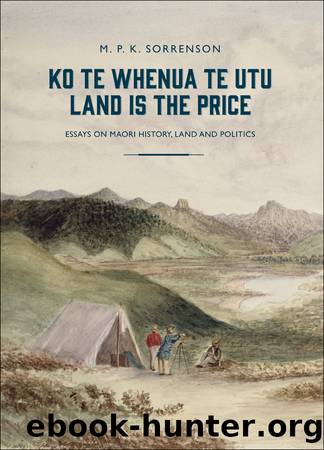Ko Te Whenua Te Utu Land is the Price by M.P.K. Sorrenson

Author:M.P.K. Sorrenson [Sorrenson, M. P. K.]
Language: eng
Format: epub
Tags: History
Publisher: Auckland University Press
Published: 2014-03-20T00:00:00+00:00
Maori Representation in Parliament: The Second Phase, 1887â1935
In 1887 two talented English-speaking Maori won seats in the House: Hirini Taiwhanga for Northern Maori and James Carroll for Eastern Maori. Taiwhanga was educated at St Johnâs College in Auckland, and then worked as a surveyor and government assessor. He was no stranger to politics, having contested every election for Northern Maori since 1871. According to Ward, he was âtoo excitable and radicalâ for Ngapuhi in the 1870s but he gradually won their trust in the next decade through involvement in the Maori Parliament and Treaty of Waitangi movement.63 However, Taiwhanga was much distrusted by Europeans, mainly because of his organisation of Tawhiaoâs visit to England in 1884. Taiwhanga quickly made his mark in the House and in 1888 was involved in a famous âstonewallâ when he attempted to delay the passing of a Native Land Bill designed to facilitate settler purchase of Maori land.64 But Taiwhangaâs one-man filibuster was soon put down and the Bill was passed. His colourful contribution to Parliament ended with his death on the eve of his probable re-election in 1890. In 1893 the equally gifted and rather more stable Hone Heke, a nephew of the leader of the 1845 rebellion, won Northern Maori and represented the electorate until his death in 1909.
James Carroll, the new member for Eastern Maori, was to play a more substantial role in Parliament than either of the members for Northern Maori. Carroll was part Irish, part Maori. Though he had only two years of formal schooling, Carroll was employed as a clerk in the Lands Department and then as Native Interpreter to the House of Representatives. It was here, no doubt, that Carroll began to acquire his knowledge of parliamentary procedure and debate that made him one of the finest speakers in the House. He stood unsuccessfully against Wi Pere for Eastern Maori in 1884 but defeated him in 1887. Carroll held the seat until 1893 when he switched to the European seat of Waiapu until 1908 and then to Gisborne which he held until 1919. To hold these seats he had to tend the interests of Pakeha electors while also trying to protect the welfare of Maori. As a staunch supporter of the Liberal Party, Carroll was soon appointed to Cabinet: as Member of the Executive Council Representing the Native Race in 1892, Minister for Stamp Duties in 1896, and Minister of Native Affairs in 1899, holding that office until the Liberals were defeated in 1912.
As Minister of Native Affairs, Carroll gained an unprecedented degree of Maori support for his policy and legislation.65 His Maori Councils Act of 1900 provided for the establishment of eleven tribal councils and below these numerous village committees. The councils were given authority to impose sanitation, control liquor, and promote health reform and education â belated recognition of the long-standing Maori demand for local government by tribal runanga. It was also a shrewdly conceived means of cutting Maori support for a larger form of autonomy, then being powerfully advocated by the Kotahitanga or Maori Parliament movement.
Download
This site does not store any files on its server. We only index and link to content provided by other sites. Please contact the content providers to delete copyright contents if any and email us, we'll remove relevant links or contents immediately.
Never by Ken Follett(3797)
Fairy Tale by Stephen King(3221)
Reminders of Him: A Novel by Colleen Hoover(2952)
Will by Will Smith(2794)
It Starts With Us (It Ends with Us #2) by Colleen Hoover(2202)
Friends, Lovers, and the Big Terrible Thing by Matthew Perry(2123)
The Becoming by Nora Roberts(2089)
Cloud Cuckoo Land by Anthony Doerr(2035)
The Strength In Our Scars by Bianca Sparacino(1777)
Cytonic by Brandon Sanderson(1775)
A Short History of War by Jeremy Black(1763)
Go Tell the Bees That I Am Gone by Diana Gabaldon(1689)
515945210 by Unknown(1602)
A Game of Thrones (The Illustrated Edition) by George R. R. Martin(1591)
Kingdom of Ash by Maas Sarah J(1529)
Wish You Were Here by Jodi Picoult(1485)
The Last Graduate by Naomi Novik(1480)
443319537 by Unknown(1471)
The 1619 Project by Unknown(1387)
